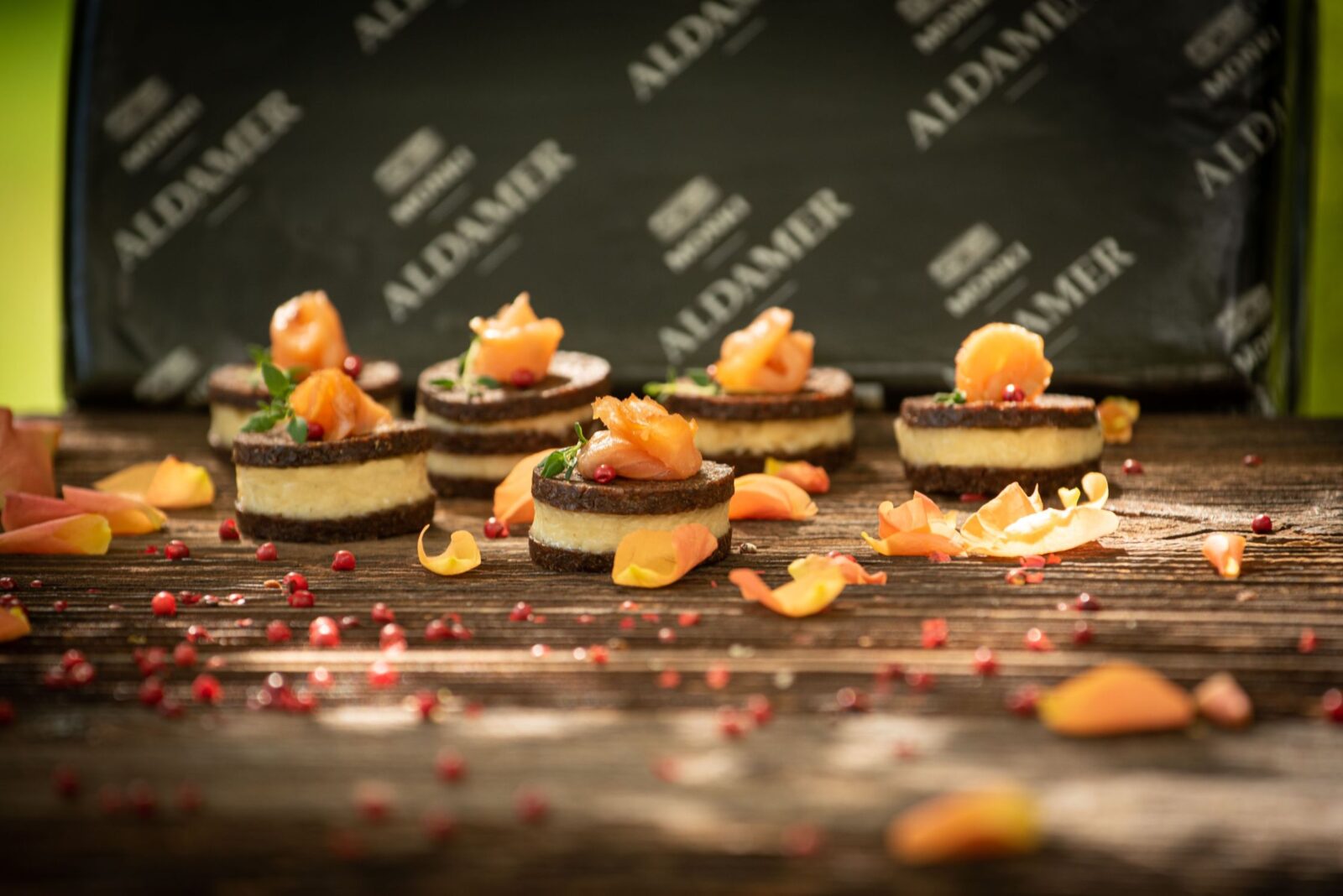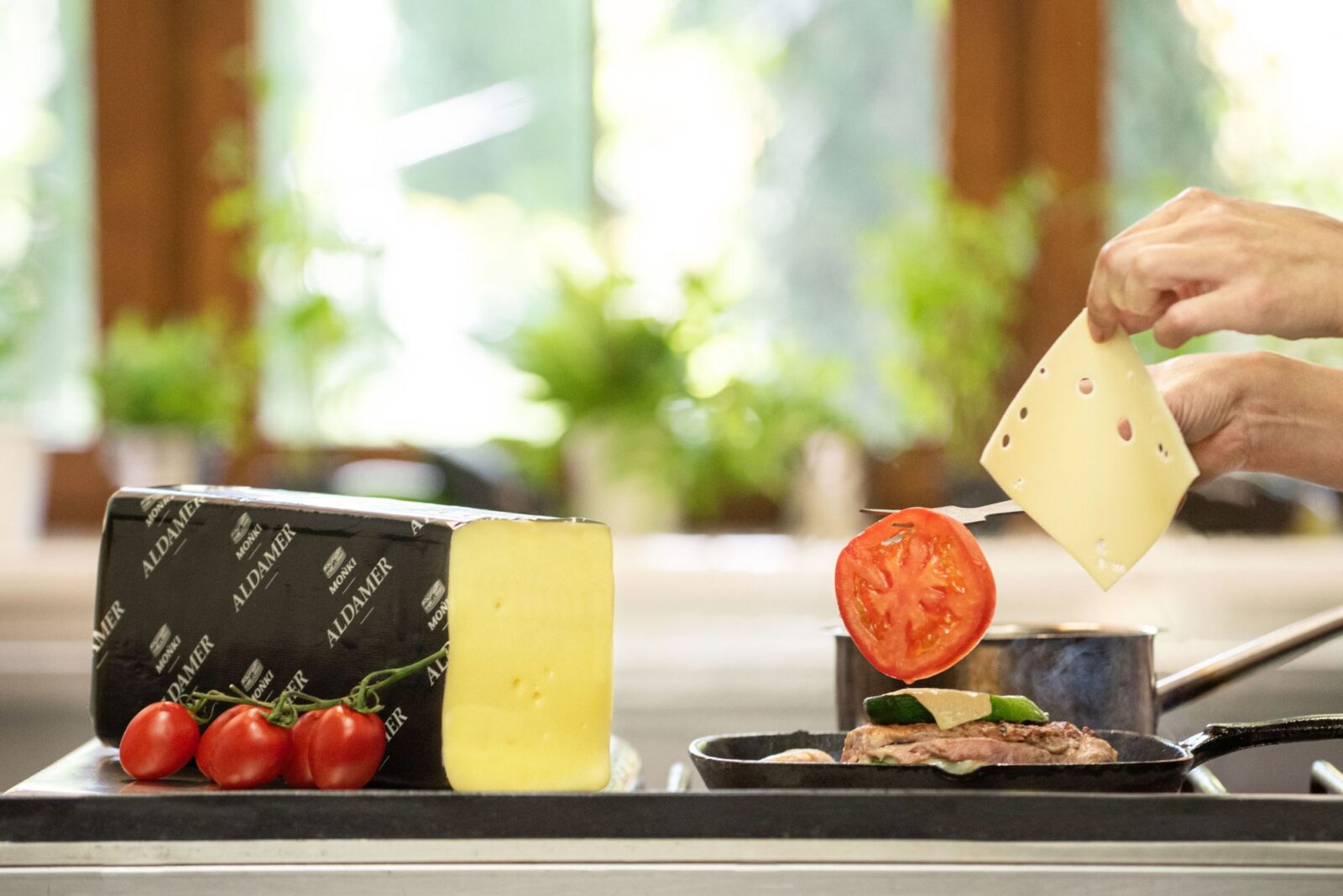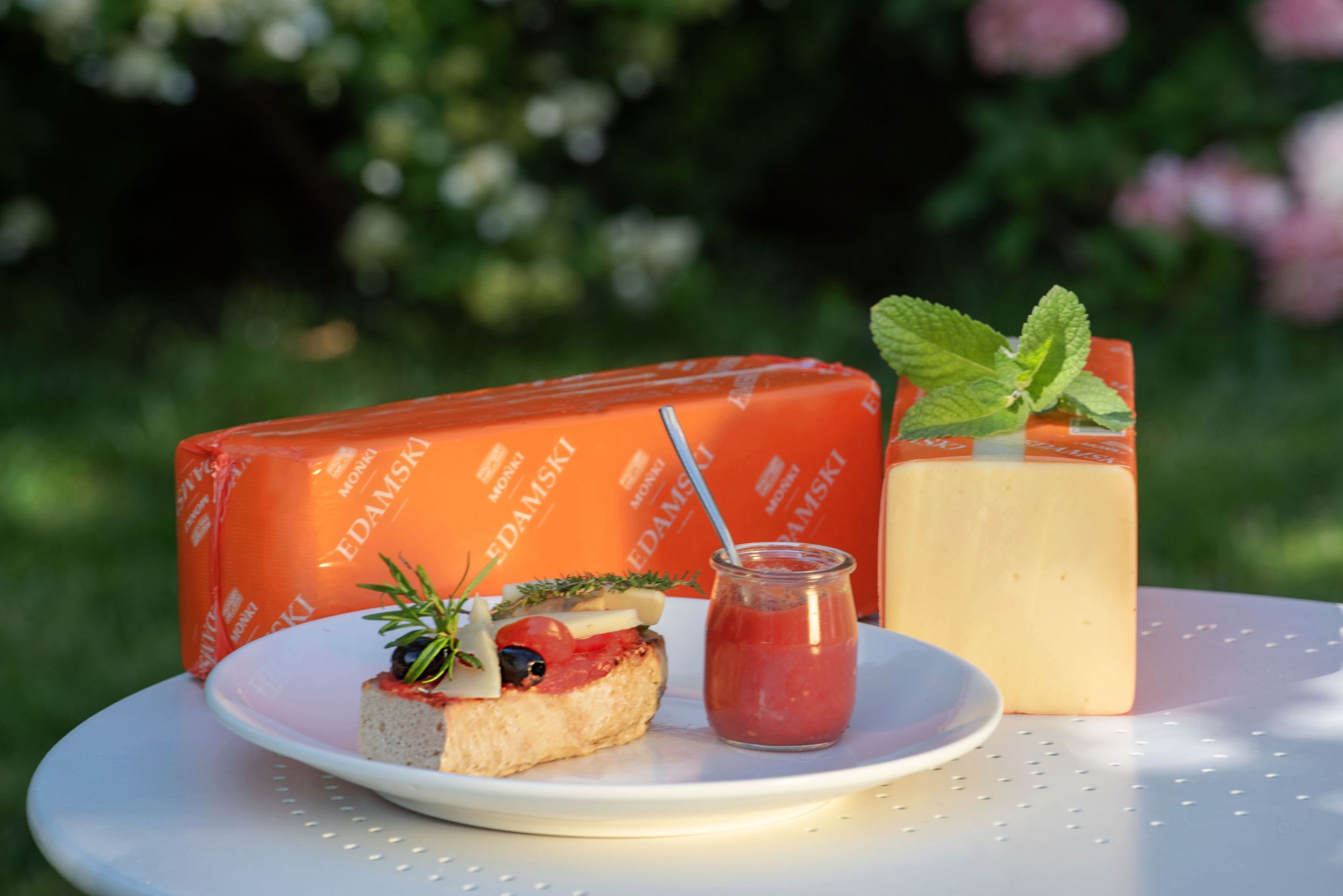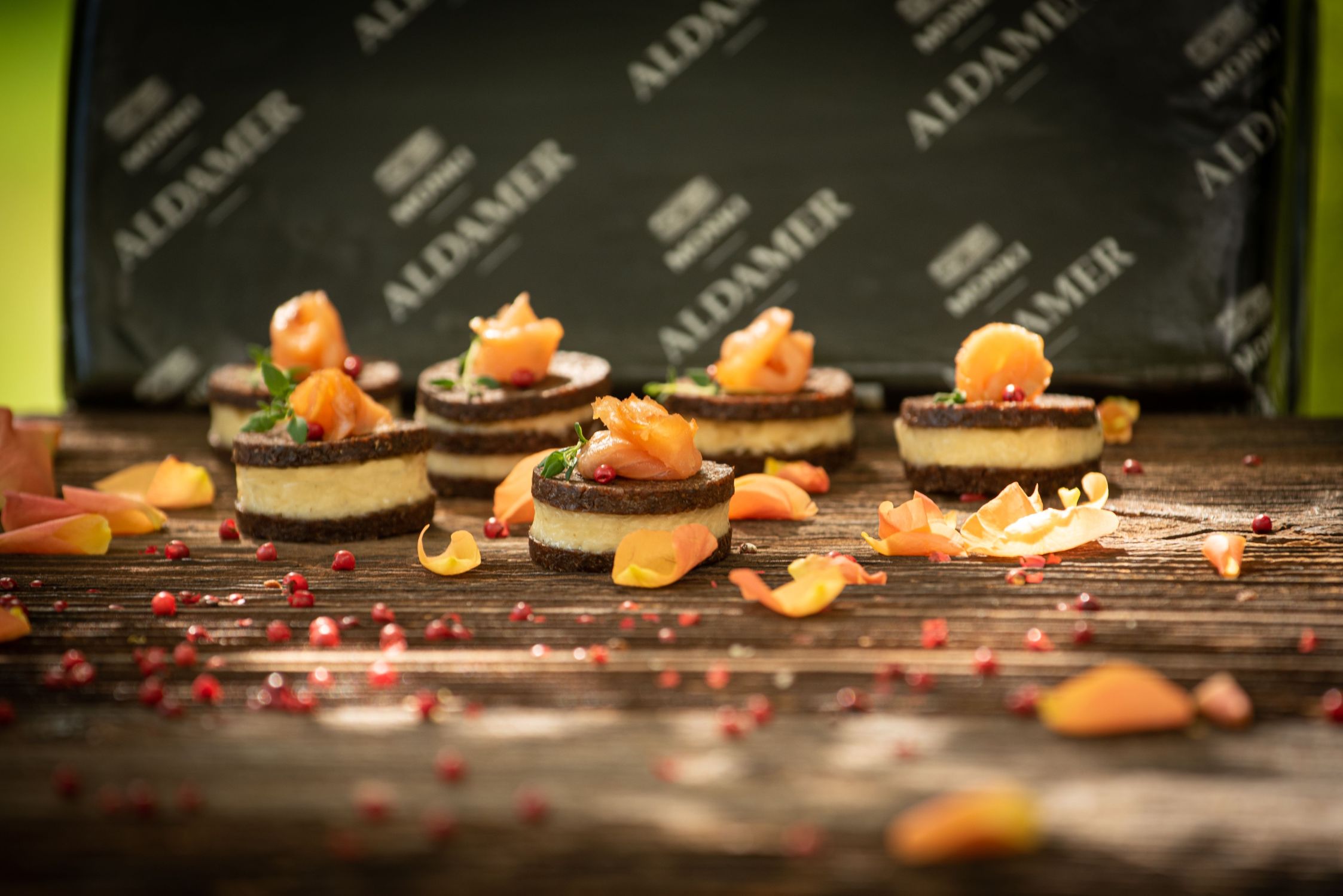Over 4,000 species, a rich history, various flavor notes and a unique aroma - cheeses are the basis of many cuisines of the world. We like to complement simple, everyday and slightly more exquisite dishes with them, and we are also happy to use them as a snack with delicate wines or other drinks. How did it all start? What is the cheese-making process like today? How does MSM Mońki cheese producer work?
- From antiquity to today, that is, about the history of cheese
- The production of cheese in antiquity
- The production of cheese in the Middle Ages
- How are cheeses made today?
- Where do the holes in the cheese come from?
- MSM Mońki cheese producer
- Everyone will find something for themselves - types of cheese
- Production of Gouda cheese
- MSM Mońki - producer of Dutch type cheeses
- Swiss cheese production at MSM Mońki
- MSM Mońki - producer of sliced cheese
- Why is it worth eating yellow cheese?
- How to buy the best cheese?
- The careful production of cheese is not enough - it is stored and served
- Cheese board - a simple snack for any occasion
- A handful of ideas for cheese dishes
- Step-by-step production of butter
- MSM Mońki - producer of powdered milk
- Whey powder - production, properties and application
- A few words at the end
From antiquity to today, that is, about the history of cheese
The beginnings of cheese making are closely related to animal breeding. The first sheep and goats were domesticated in Iran as early as 8,000 BC 6,000 BC their breeding began in the Apennine Peninsula, southern France and North Africa. Cattle appeared on farms around 6,000 BC in Anatolia and Macedonia, and around 4,000 BC in the Balkans.
The tradition of cheese making dates back to 7500 BC Based on archaeological research, it has been established that it was then that the oldest cheese in the world resembling today's mozzarella was created. Interestingly, this happened not in France or Switzerland, i.e. countries that are considered precursors of cheese making, but in today's Poland. Earthenware, approximately 5-liter vessels resembling those used today, was found in Kujawy - they had holes that could be used to drain the whey. The find was subjected to specialized chemical tests, which showed the presence of milk at the edges of the holes. The results left no room for doubt. The dishes were used to make cheese. At present, it is Poland that can be considered the country with the longest cheese traditions not only in Europe, but all over the world.
Cheese making has a long tradition. As a producer of various types of cheese, MSM Mońki takes all the best from classic recipes, offering products filled with exceptional taste and aroma. MSM Mońki Swiss and Dutch cheeses are an excellent addition to hot and cold dishes, as well as a nutritious snack that can be enjoyed between meals.

The production of cheese in antiquity
Cheese production is a complex and complicated process. It requires specialist knowledge, experience and the use of appropriate equipment. Today's cheese producers use the facilities offered by modern technologies. The process is often mechanized, and people's work is limited to selection and supervision. What was it like in ancient times? How was cheese made when high technology, innovative equipment and other amenities did not exist?
Thanks to specialized archaeological research, we can perfectly understand the history of cheese making. The first document that details the production process is considered to be a Sumerian bas-relief called "the ornament of the dairy". The document was found in Iraq at the Tell al-Ubaid archaeological site near the ancient city of Ur. It is estimated that it may date from around the 3rd millennium BC
What information is provided on the plate? The first stage of cheese making was pouring the milk into special wineskins made from sheep stomachs. It has been noticed that milk stored in this way is divided into curd and whey. Over time, it was learned to strain the curd, dry it and salt it for longer preservation. Interestingly, this ancient method is still used in Arab countries to create dairy products called "kashk".
The cheese-making process developed in ancient Greece. A little later, the Romans took over the skill. In ancient Rome, it was practiced to leave sheep's and goat's milk to sour independently. Sometimes this process was accelerated by mixing the liquid with fig tree twigs, adding fig juice or throwing wild thistle seeds into the vessel. The Romans learned the methods of cutting milk with rennet from the Etruscans.
Cheeses were also popular in the great Byzantine Empire. They were considered the basic addition to bread. He has hosted the tables of the populations of all states. Interestingly, some historical sources say that during the development of the Empire, cheese was a gift for friends.
The production of cheese in the Middle Ages
Over time, the methods of making cheeses have been improved. With the advancement of technology, new methods of production have emerged. Speaking of cheese making, it is impossible not to mention the Cistercian monasteries. They were considered to be the main centers for promoting the skill of making cheese. The names of some of the most famous French cheeses - "Maroilles" and "Port-Salut", come from the Cistercian abbeys founded in the 11th century AD.
The founding of Chiaravalle Abbey in 1115 was of great importance for the cheese industry. Thanks to numerous drainage ditches, canals and water reservoirs, vast areas were covered with green, which translated into an increase in the production of milk and cheese.
In the 18th century, the famous Encyclopedia of Diderot and d'Alembert was published, being a compendium of knowledge in the field of science, arts and crafts. It describes the process of making cheese and introduces the basic tools for its production - including copper kettles or inclined wooden tables on which whey was formed and imprinted.
The turning point for cheese making was the 19th century. It was then that a lot of technological amenities appeared that streamlined and improved the cheese production process - e.g. a microscope, centrifuge or refrigerator. In the 19th century, a powdered milk production system was developed, milk pasteurization was used for the first time and the first industrial rennet appeared. At the end of the century, a way to read the fat content of milk was invented.
How are cheeses made today?
Today, cheese making is an important foundation of the dairy industry. Currently, about 4 thousand. types of cow, sheep and goat milk cheese. In Poland, over 600 were produced in the period 1948-2019! Many types of cheese that reign in today's market are made according to traditional recipes developed centuries ago. MSM Mońki is a producer of Dutch and Swiss cheeses, which combines the tradition of cheese making with the latest technologies. How does cheese production look like in Moniecka Spółdzielnia Dleczarska?
Cheese is made by the precipitation of fat and protein from milk. However, a long time passes before the finished product hits the store shelves. The milk used to make the cheese must undergo thorough tests, including analysis for the presence of antibiotics, chemical tests of dry matter, degree of acidity and fat, protein and lactose content, and a microbiological analysis of the total number of bacteria and somatic cells. Milk must meet strict guidelines, no matter what type of cheese is ultimately made from it.
The thoroughly tested milk is placed in a centrifuge. There, the fluid undergoes bactofugation (a process of cleaning from cells and bacterial spores). In the case of hard cheeses, the milk is additionally pasteurized.
The milk is cooled to the "dressing" temperature and mixed with the rennet, calcium chloride and leaven. As a result of combining these ingredients, after about 30 minutes, a curd is formed, which is the basis of the final product of milk processing in the cheese process. The mass is cut and mixed until the cheese grains and whey are formed. Then the product is heated so that the grains take the right shape.
The next step is to drain the whey from the grains and mass. The process gives the cheese the right shape. The finished product is placed in brine for 1-2 days, depending on the species. After this time, the cheese is waxed or packed in heat-shrinkable bags.

About 4 days pass from the moment the milk is purchased from the farm to the cheese is packed. However, it doesn't stop there. The next stage is maturation, which is crucial in production. During the maturing process, the cheese acquires the characteristics typical of a specific type - it acquires the appropriate texture, color, taste and aroma. The temperature at which the cheese is "aged" is of great importance for the success of the process. Dutch cheese producers use a temperature of 8-12 ° C, while Swiss cheese producers - 18-22 ° C. The cheese usually takes 3 to 6 weeks (sometimes longer) to mature. It all depends on the effect that the manufacturer wants to achieve.
Where do the holes in the cheese come from?
Why do some types of cheese have smaller or larger holes and others not? The reason for this is in the production process. The holes in the finished product are the result of the action of propionic bacteria cultures. The bacteria convert the lactic acid into propinoic acid, which gives the cheese its characteristic slightly nutty flavor. During the process, carbon dioxide is released. The dioxide pushes the cheese flesh, creating bubbles that make it difficult to escape through the thickening mass. As a result, holes are formed.
The cultures of propin bacteria responsible for the eyes in cheese are only used for the production of Swiss-type cheeses such as ementaler or mazdamer. The holes in Swiss cheese are the size of a cherry or a nut.
MSM Mońki cheese producer
The best cheese producers in Poland try to combine the tradition of cheese making with what today's reality offers. Contemporary cheesemakers eagerly use the achievements of their predecessors, and at the same time use innovative technologies, thus creating products filled with unique taste and aroma.
Moniecka Dairy Cooperative belongs to one of the most innovative dairy plants operating in Poland. Large investment outlays enable smooth and systematic expansion and modernization of the company. Automatic lines for the production of maturing cheese with a capacity of up to 600 thousand. liters of milk per day are just one of the many amenities that allow us to operate quickly and efficiently, and at the same time fully professionally.
Customer safety and the highest quality of products are our priorities. We obtain milk from the best suppliers, we take care of full professionalism at every stage of production and we make sure that the raw material meets the strict safety standards. The confirmation of the excellent quality are, among others The Company Code of Good Manufacturing Practice / Good Hygiene Practice GMP / GHP and the HACCP System.
Everyone will find something for themselves - types of cheese
At the very beginning of the text, we mentioned that there are over 4,000 people in the world. types of cheese. We can divide them according to the type of milk used, fat content, production process, technologies used, and the type and time of maturation. Depending on the type, the cheeses differ in taste, aroma, consistency, nutritional value and purpose.
Cheeses are most often classified according to the production technology and type of maturation. We distinguish species:
- rennet - soft with mold growth (brie, camembert), with mold growth (roquefort, gorgonzola) and austained (bryndza), semi-hard (Tilsit, Limburgish) and hard (gouda, ementaler, yellow mozzarella, Parmesan, radamer),
- acidic - unripened (cottage cheese) and ripening (lump).
Rennet cheeses are obtained by curdling the milk with the use of natural or microbiological rennet. Then the mass is matured. Soft cheeses are light and delicate, semi-hard cheeses are sticky and brittle, while hard cheeses are quite flexible.
In the production of acid cheeses, the curd is mechanically and thermally processed. For the production of cottage cheese, skimmed milk (low-fat cheeses) or standardized (high-fat and semi-skimmed cheeses) are used.
In addition to rennet and acid cheeses, we will also mention acid-rennet (cottage cheese) and short-cheese (ricotta) species.
Another popular division of cheeses is fat content. According to her, cheeses are divided into:
- cream - rennet 50% fat in dry matter, and acid 55%,
- full fat - 45% and 42% respectively,
- greasy -40% and 30%,
- semi-skimmed - 20% and 15%,
- degreased - 10-20%, only rennet,
- lean - & lt; 10% and & lt; 14%.

Production of Gouda cheese
Gouda is one of the most popular dairy products on the Polish market. According to sources, its tradition dates back to the 12th century. The name of the cheese comes from the town of Gouda, located near Rotterdam.
Gouda is a hard, ripened rennet cheese made from cow's milk. Its production in Moniecka Spółdzielnia Dleczarska is similar to other cheeses of this type:
- pasteurized milk is mixed with rennet,
- a curd is formed, which is crushed and drained until it becomes a cheese mass,
- the mass is placed in round molds and soaked for several days.
The last - and at the same time the most important - step in the production of Dutch Gouda cheese is its maturation. This process may take up to several years. The absolute minimum is 18 weeks. The longer the cheese matures, the more flavor and aroma it gains.
Gouda is valued for its versatility. It goes well with sandwiches and casseroles. It goes well with white wine, fruit or quince jam.
MSM Mońki - producer of Dutch type cheeses
MSM Mońki wants to meet the expectations of all customers. Our goal is to conquer the palates of the greatest gourmets and host people of various tastes on the tables. We pursue our goal by offering a diverse assortment, tailored to the requirements of even the most demanding cheese connoisseurs.
Moniecka Spółdzielnia Dleczarska is primarily a Dutch-type cheese producer. Podlaski with a springy texture and intense flavor, Edamski with a slightly nutty note and mild, subdued flavor, Sea with an original aroma, or the most popular Gouda ripening cheese, valued for its creamy, distinctive taste and perfect texture - everyone will find something for themselves.
Swiss cheese production at MSM Mońki
The second large category is Swiss species with characteristic holes that give them a unique appearance. MSM Mońki is a producer of Nadbiebrzański cheese, which is distinguished by its delicacy and slightly sweet taste. The offer of Swiss cheeses is completed by aromatic Moniecki cheese and mild Aldamer, which is perfect as an addition to light wine.
The offer of Moniecka Spółdzielnia Dleczarska also includes products such as:
- extra butter with an extremely creamy consistency,
- powdered whey, which is the basic element in the kitchen of every baker and confectioner,
- powdered milk, which is perfect for a variety of baked goods.

MSM Mońki - producer of sliced cheese
A modern customer focuses on comfort. As consumers, we like simple and practical solutions that facilitate the daily preparation of tasty home-made dishes. The MSM Mońki cheese producer meets the expectations of its customers by offering sliced cheeses packed in functional, airtight packaging.
What cheeses are available in a sliced version? First of all, adored by young and old Gouda, famous for its perfectly creamy taste and stimulating aroma. Sliced Gouda is the perfect solution for sandwiches.
Lovers of perfectly balanced flavors will surely appreciate Podlaski cheese. MSM Mońki Podlaski cheese is delicate, slightly sour and has a perfectly soft, elastic flesh. All the advantages of Podlasie are encapsulated in the naturalness of the cheese.
Edam cheese in slices offered by MSM Mońki is natural with a nutty note. It is a great addition to crunchy homemade bread and sweet jam. It is perfect for a duet with challah, butter bun or yeast cake.
A characteristic feature of Morski cheese in slices produced by MSM Mońki is its milky taste. It has a mild structure and a light texture. It dissolves well, making it a perfect match for homemade casseroles and toasts.
MSM Mońki is also a producer of Aldamer cheese in slices. Aldamer is a Swiss-type cheese with a mild, subtly sweet flavor. The firm flesh is decorated with holes the size of hazelnuts. Aldamer cheese slices are perfect for cold and hot dishes, including sandwiches, casseroles and party snacks.
Why is it worth eating yellow cheese?
There are many dietary myths around cheeses. Many people find them unhealthy and fattening. Completely wrong. Yes, cheese is high in energy and can contribute to weight gain if we eat too much of it. However, when eaten in moderation, they are very healthy and can bring many benefits to the entire body. Real cheese, produced according to a traditional recipe, is a treasure trove of valuable nutrients.
Cheese, as a derivative of milk, is an excellent source of calcium (even 160-200 mg in one slice). Calcium is one of the most important minerals for the human body. It is necessary for the proper functioning of many mechanisms - it builds connective tissue, bones and teeth, participates in the process of blood clotting, regulation of certain hormones, conduction of nerve impulses and cell regeneration. Calcium is used in the prevention and treatment of osteoporosis, in the case of heavy metal poisoning and inflammation.
The yellow cheese also contains vitamin B12, which is responsible for maintaining the circulatory, nervous and digestive systems in excellent condition. Vitamin B12 is involved in the production of nucleic acids and red blood cells, is responsible for many metabolic reactions, forms the myelin sheath of nerve fibers, and supports the synthesis of important neurotransmitters, including dopamine.

Other valuable substances found in cheese are:
- potassium - a micronutrient responsible for regulating the pH level of cells, proper conduction of nerve impulses; glycogen resources also depend on its concentration in the body, which guarantees the proper functioning of the muscles,
- phosphorus - an element that affects the skeletal system, is involved in the processes taking place in the nervous system and contributes to the maintenance of the acid-base balance of the body,
- zinc - a chemical element important for skin, hair and nails; participates in the regulation of the pancreas, and thus affects the proper secretion of insulin.
It is also worth mentioning that cheese is an excellent source of protein that we need for proper functioning. 100 g of cheddar cheese contains 25 g of protein, in 100 g of gouda - over 27 g, and in 100 g of emental - over 28 g! Protein provides energy, supports the building of muscle and bone tissue and helps regulate the metabolic economy.
How to buy the best cheese?
Cheese is best purchased in smaller quantities, but more often. Such practice guarantees the highest quality and excellent taste of the product. In addition, it prevents you from throwing away spoiled food - which is of great importance these days.
In order to benefit from all the beneficial nutritional values of cheese and at the same time enjoy the unique taste and unique aroma, you should choose a product prepared according to a carefully prepared recipe from the best milk. Producers of cheese should buy the raw material only from trusted suppliers and ensure high standards at every stage of its processing.
The idea of MSM Mońka is to strive for the outstanding quality of the created products! We make sure that the milk used to produce our cheeses meets strict standards. We obtain the raw material from local farms. We only work with trusted suppliers who are able to provide us with extra-class milk. By combining the excellent quality of ingredients with the latest technology of cheese making, we can produce unique products that conquer even the most demanding taste buds.
We operate in the Biebrza Valley, where the wildness of the landscape and the beauty of nature reign. We respect what surrounds us and we derive the best of it. We love the naturalness that manifests itself in the taste of our cheeses. Creamy and light, and at the same time expressive and full of a unique aroma - the products of the Dutch and Swiss cheese producer MSM Mońki appeal to the taste of even the most demanding!
MSM Mońka's products are of excellent quality confirmed by numerous awards. Gouda, Aldamer and LUX MSM Mońki cheeses were awarded in the XXIV National Cheeses and Curds Assessment. The Commission of Super Arbitrators, taking into account the correct labeling, aesthetics and functionality of the products and additional information on the packaging, awarded MSM Mońki 4 medals to them. prof. dr hab. Zbigniew Śmietana in various categories. The award was a great success!
MSM Mońki can also be proud of the Award of the President of AR and MR for the 7th place in the ranking of the Best Dairy Cooperatives, received during the Mleko-Expo fair organized in 2019.

The careful production of cheese is not enough - it is stored and served
Many factors influence the quality, taste and aroma of a cheese. We have mentioned that the most important are the production process and the class of ingredients used. However, no less important is how we store the purchased product.
Sliced cheese should be stored in its original packaging or in food or aluminum foil. The air supply is the main culprit behind the spoilage of the cheese. MSM Mońki products are packed in practical "open-close" packaging. Thanks to them, customers can enjoy the full flavor and aroma as well as the exceptional freshness of the cheeses for many days.
Cheese board - a simple snack for any occasion
First of all, cheeses are an excellent snack. The iconic cheese board is a great solution for crazy parties with friends, parties with the family or romantic evenings for two.
What cheeses to use to prepare such a delicacy? The key to creating a unique composition is diversity. It is worth focusing on products that differ in taste, consistency and method of production. It is best to combine light, creamy varieties with semi-hard and hard varieties. The cheeses of the Moniecka Dairy Cooperative are perfect! The board cannot miss the Swiss Nadbiedrzański rennet cheese, which is distinguished by a mild taste with a slightly sweet note. The obligatory ingredient of the board is Gouda MSM Mońki cheese with a delicate flavor, elastic flesh and stimulating aroma. The composition will be perfectly complemented by soft Camembert, Italian Parmesan and aromatic Limburger.
It is worth remembering that cheese tastes best when its temperature is about 2-3 ° C lower than room temperature. In order to enjoy the appropriate structure that will allow you to learn about the intense flavor and aroma of the cheeses, it is worth taking them out of the refrigerator at least one hour before consumption.
A handful of ideas for cheese dishes
Cheese is an ingredient of many delicious sweet and savory dishes. It can be used both in simple meals every day, as well as in exquisite dishes reminiscent of real works of art from the most exclusive restaurants.
First of all, cheese is the basic addition to homemade pizza! Which pizza cheese should you choose? According to a traditional Italian recipe, it should be mozzarella. The mild taste of mozzarella goes perfectly with the dough. In addition, it dissolves perfectly during baking.
Cheese lovers can choose between gouda and cheddar. On the other hand, those who like creamy products will surely like ricotta pizza.
Other dishes that taste great with cheese include:
- pasta and potato casseroles,
- croutons and sandwiches,
- pierogi,
- pasta,
- meat,
- Lasagna,
- tortillas,
- burgers,
- light salads,
- soups.
Step-by-step production of butter
On store shelves, we can find a lot of products known as "butter". However, few of them actually have a perfectly creamy taste and a delicate, creamy texture. Butter is divided into 4 types: extra, delicatessen, choice and table. The first 3 must contain a minimum of 80% fat and no more than 16% water. The table types, on the other hand, consist of min. 73.5% of fat and max. 24% of water. Extra butters are considered the best. They are appreciated for their delicate, creamy taste, unique aroma and perfect consistency.
The production of extra butter should follow strict, well-defined rules. The process is divided into several stages. In the first one, the milk is centrifuged in order to separate the cream. The cream obtained in this way usually consists of 30-35% fat and has a slightly creamy or white color.
To destroy harmful bacteria, yeasts and molds, the cream is pasteurized at a temperature of around 90 ° C. Then, the degassing process is carried out, which consists in removing volatile substances from, for example, the products of microflora activity.
The next stage is cooling the cream, otherwise known as physical maturation. Often, biological maturation, i.e. the fermentation process, is carried out simultaneously, which gives the final product a refreshing taste and specific aroma. What's more, sometimes dyes (e.g. beta-carotene or annatto) are added to the mass, which are responsible for the characteristic color of the finished butter. However, these are not necessary steps.

The churning of the cream is essential in the production of butter. This is a special mixing process that transforms an oil-in-water substance into a water-in-oil substance, i.e. butter. In order to get rid of the remnants of buttermilk, protein and lactose from the fatty grains, the buttermilk cream is rinsed with water. Rinsed grains can be salted (not necessarily). The beans are then kneaded to remove excess water. The product prepared in this way is formed and packaged.
Mońki MSM extra butter is an excellent addition to sweet and savory dishes. It goes perfectly with fish, meat and pasta. In addition, it is a great base for crispy, delicately creamy cakes and cookies. Extra butter has a unique taste and unique aroma enclosed in a small cube!
MSM Mońki - producer of powdered milk
Powdered milk is a dairy product obtained by concentrating cow's milk (whole, standardized or skimmed milk) and drying it. Powdered milk production technology was developed over 150 years ago, in 1855 to be exact. Standardized or skimmed milk is first pasteurized. Its purpose is to eliminate all microorganisms and destroy the enzymes native to milk. In order to get rid of up to 50% of water in milk, the producer concentrates it in special vacuum evaporators. Water evaporates from the condensed milk again - this time in spray dryers. The process takes place at a temperature of 140-200 ° C.
Why is the water in the milk evaporated in two steps? Pre-compaction not only improves the properties of the finished product, but also saves a lot of energy during the second vaporization, making the process more economical.
The finished product must have specific parameters, including proper wettability, solubility, stability and appropriate chemical composition. The production process should be such that heat treatment and pasteurization do not adversely affect its properties and nutrient content. The producer of milk powder should subject the finished product to an organoleptic inspection.
Powdered milk is valued for its versatility and wide application possibilities. Companies willingly use them in the production of yoghurts, ice cream, bread and cakes. It is also perfect as an ingredient of homemade desserts and pastries - including the chocolate block, which is a cult delicacy from the times of the Polish People's Republic.
Whey powder - production, properties and application
Powdered whey is currently one of the most popular food additives used in food production. It is an ingredient of chocolates, soups, sauces, processed cheese, baby food and ice cream. Interestingly, for a long time it was treated as a by-product of no value. Its valuable properties were discovered only later, and thus it became an important element of dairy processing. Today it is used to improve the taste, structure and other sensory features of many food products - it gives the appropriate color to the crust of bread, improves the quality of meat and fish, and adds fluffiness to the food.
How is whey powder made? The sweet rennet product is produced during the production of cheese, and the acidic one in the production of cottage cheese. Powdered whey is obtained by evaporating some of the water from the liquid whey. The substance is preheated to 58-60 ° C using plate heat exchangers and then heated at 65 ° C with steam. The obtained product is dried in a drum or spray dryer.
Whey powder is a treasure trove of valuable nutrients. Properly produced, it is a source of perfectly digestible whey proteins and has a high lactose content with a low glycemic index. Whey prepared on the basis of natural ingredients is rich in calcium, potassium, B vitamins, magnesium, zinc and phosphorus. As a result, it has a beneficial effect on the entire body - it lowers cholesterol, protects the stomach and intestines, and improves the appearance of hair and nails. Moreover, it is easily digestible.
A few words at the end
Cheese has been on our tables for centuries. In ancient times, cheese production was a form of extending the shelf life of milk. In the Middle Ages, cheese was an important part of the diet of people from all walks of life. Today it is one of the tastiest snacks and additions to various dishes.
We love cheeses for variety. Soft rennet species delight us with their delicacy and lightness, the semi-hard and hard versions encourage with their unique aromas, and the acidic ones bring a refreshing note to the diet. Cheese goes well with many food products. You can use them in simple dishes and exquisite dishes - sweet and dry.
As a producer of Swiss and Dutch cheese and other dairy products, MSM Mońki aims to win the palates of the greatest gourmets. The highest production standards, excellent quality of ingredients and naturalness, which is manifested at every stage of operation - all this translates into unique flavors, exceptional textures and freshness of the offered products. Enjoy nature! Taste Mońki MSM cheeses that melt in your mouth and find out what real pleasure is.
How to store cheese?
Cheese is a delicate food item. If stored improperly, it may lose its precious values and unique taste. Cheese, like any other dairy product, should be kept in the refrigerator. The optimal conditions for slowing down the multiplication of harmful bacteria and microorganisms are approx. 4-7 ° C (middle and upper shelves in the refrigerator).
How to use whey in the kitchen?
The acidic type is perfect for acidifying soups and sauces. It can be successfully added to Ukrainian borscht, cold soup or sour soup. In addition, it can be a good addition to sourdough bread. Sweet whey is added to pastries, cocktails and desserts.
How to serve cheese?
Cheeses should be served with sweet and savory additives. Depending on the concept and preferences, you can use: grapes, strawberries, dates, raisins, walnuts, grissini, bruschetta, pesto, olives, honey, meats or preserves.

